
Light Week at the End of the August Holidays
Estimated reading time: 16 minutes
- Global Economic Review: Late August 2025
- U.S. Economic Review
- U.S. Economic Outlook
- Wall Street – Recent Performance and Weekly Outlook
- USD – Recent Performance and Weekly Outlook
- Japanese Economy – Current Conditions and Week Ahead Outlook
- Gold Market – Current Trends and Week Ahead
- Crude Oil Market – Current Trends and Weekly Outlook
- Cryptocurrency Markets – Overall Review and Bitcoin Expectations
Global Economic Review: Late August 2025
The end of August marks a light data week but notable shifts in the global economic landscape. Central banks are increasingly diverging in policy, reflecting varied inflation dynamics and local growth conditions in the complex post-pandemic environment.
At the Jackson Hole Symposium, major central bankers—including Fed Chair Powell—emphasized ongoing challenges in balancing inflation control with growth support. Powell indicated openness to future rate cuts but maintained a cautious tone, highlighting persistent inflation and labor market uncertainty. This nuanced message set a slightly dovish tone in markets, but investors remain attuned to further signals.
In the US, inflation momentum has picked up: July’s core CPI rose 3.1% year-on-year, the fastest since February, while producer prices also climbed. This complicates the Federal Reserve’s path, though market expectations for a September rate cut remain high, with futures pricing in a 75% chance.
Contrastingly, policy easing is underway in the Asia-Pacific. The Reserve Bank of New Zealand and the Reserve Bank of Australia both lowered rates, citing moderating inflation and a cooling labor market. Further easing is expected as these economies face slower growth and subdued price pressures.
China’s July data pointed to broad economic weakness, with disappointing retail sales and deflationary producer prices. The People’s Bank of China held key rates steady, but more stimulus is anticipated to counteract fading momentum.
Europe remains subdued, with weak data and deteriorating sentiment, particularly in Germany. The UK saw inflation unexpectedly rise, especially in services, complicating the Bank of England’s outlook and delaying likely rate cuts. Meanwhile, Canada’s July CPI softened thanks to falling gasoline prices, but the Bank of Canada is expected to wait for further confirmation before easing.
Across regions, central banks remain highly data dependent as inflation, growth, and policy paths diverge entering the final months of 2025.
Financial markets have shown a mix of optimism and caution in response to shifting global economic signals. Equities continued their summer rally, with some markets—including Japan’s TOPIX—reaching multi-year highs amid strong economic data. U.S. stocks also advanced, supported by expectations of potential Fed easing. Meanwhile, demand for safe-haven assets grew, pushing gold prices near record levels as investors hedged against uncertainty and dollar weakness. Crude oil faced downward pressure from oversupply concerns but saw a modest rebound. Overall, markets are navigating between hopes that inflation has peaked and concerns about slowing global growth, reflecting the current inflection point in the global economy.
U.S. Economic Review
The U.S. economy showed mixed signals last week as consumer spending remained resilient while inflation pressures persisted and labor market conditions softened. Although July retail sales posted a solid 0.5% month-over-month gain, continued strength in consumption helped offset ongoing manufacturing weakness and a slight decline in industrial production. The labor market, though no longer at its tightest, remains relatively firm, with July payrolls showing steady job gains and unemployment hovering near historic lows. However, jobless claims have drifted higher, and finding new employment has become more difficult, suggesting some cooling in labor demand.
On the inflation front, July data indicated persistent price pressures. Headline CPI held steady at 2.7% year-over-year, but core inflation accelerated to 3.1%, the highest since February. Producer prices surged 0.9% for the month, pushing annual PPI inflation to 3.3%, partly driven by tariff-related costs filtering through supply chains. Broader inflation measures, like the trimmed-mean CPI, also showed more widespread price increases, reinforcing the challenge for the Federal Reserve.
Financial markets remain focused on the Fed’s next steps, with futures pricing in a 75% probability of a September rate cut. FOMC meeting minutes reflected divided views among officials: some see recent troubling inflation data as temporary, while others stress the need to remain data-dependent. The consensus is that, although inflation is above target, underlying pressures are moderating relative to 2024, potentially opening the door for monetary easing.
The housing sector remains a weak spot. July existing home sales rebounded 2%, but the overall 2025 trend is flat, with elevated mortgage rates and high prices suppressing demand and slowing price appreciation. Residential investment has contracted and is expected to remain a drag on growth. Consumer confidence also softened in August, with households expressing greater concern about inflation and current economic conditions.
U.S. Economic Outlook
Looking ahead to the week of August 25–31, 2025, the U.S. economic calendar is busy, with several key data releases set to shape the near-term outlook and influence Federal Reserve expectations. The highlight will be Thursday’s revised GDP figures for Q2. The advance estimate showed robust 3.0% annualized growth; the second estimate from the Commerce Department will be closely watched for notable revisions, particularly in consumer spending or business investment. Confirmation of strong Q2 growth would support the “soft landing” narrative, while any downgrades could spark concern.
Inflation takes center stage on Friday, when the Fed’s preferred gauge—the Core PCE Price Index for July—is released. July CPI showed headline inflation steady at 2.7%, with core CPI picking up to 3.1%. Since core PCE typically runs lower than CPI, this report will be crucial for shaping expectations on rate cuts. A softer-than-expected print would reinforce hopes for Fed easing, while an upside surprise could give policymakers pause. Alongside PCE, July’s personal income and spending data will show whether consumer momentum continued into Q3. Sustained spending would suggest a solid start to the quarter, while stagnation could indicate mounting headwinds from shrinking savings or higher prices.
The U.S. housing market remains under pressure, with builders offering various incentives to attract buyers, but high mortgage rates continue to limit affordability and buyer activity. New home sales are expected to show a slight monthly increase in July, reaching a 638,000-unit annual pace, but remain 7% below last year’s level.
For durable goods, restrictive borrowing costs and uncertainty are weighing on capital investment. July’s durable goods orders are forecast to fall 1.5%, primarily due to lower aircraft orders, while orders excluding transportation are expected to edge up just 0.2%. In real terms, business equipment demand is weak, and investment is likely to contract in the second half of the year.
As the week concludes, traders will assess the second GDP estimate, the University of Michigan’s final August sentiment reading, and the advanced July goods trade balance. Overall, cautious optimism prevails: the economy remains on a moderate growth path, markets expect a September rate cut, and unless data deviate sharply, a 25 bps policy easing is the baseline scenario.
Wall Street – Recent Performance and Weekly Outlook
Wall Street ended the week on a strong note, extending its summer rally despite a weaker U.S. dollar driven by shifting rate expectations. The equity markets saw volatility early in Week 34, with the S&P 500 posting five consecutive daily losses and the Nasdaq Composite on track for its worst week since May, largely due to concerns over mixed earnings and a mid-month uptick in inflation. However, sentiment improved dramatically after Fed Chair Jerome Powell’s dovish remarks at Jackson Hole on Friday, which hinted at possible rate cuts in response to rising labor market risks. This shift triggered a robust relief rally: the Dow surged nearly 850 points to a record high, the S&P 500 jumped 1.5%, and the Nasdaq rebounded by 1.9%, cutting its weekly loss to –0.6%. For the week, the Dow rose 1.5% and the S&P 500 edged up 0.3%, as investors rotated back into growth and rate-sensitive sectors, with major tech stocks and cyclicals rebounding sharply.
The strong finish highlights the market’s optimism for continued Fed support, especially with a largely positive earnings season and diminished immediate macro risks. Still, elevated valuations leave little room for error, and September’s historical volatility may add to market jitters. While the short-term bias remains bullish, any hawkish surprises or disappointing data could spark a correction.
Looking ahead, key macroeconomic releases, especially the upcoming PCE inflation report, will be critical. A benign reading could further bolster stocks, reinforcing expectations for Fed easing, while an inflationary surprise might reignite concerns about stagflation or a policy mistake. Technically, the S&P 500’s key levels to watch are 6,135 (support), 5,900 (pivot), and 6,500 (resistance). Overall, Wall Street remains cautiously optimistic, but vigilant for potential shifts in sentiment as new data emerges.
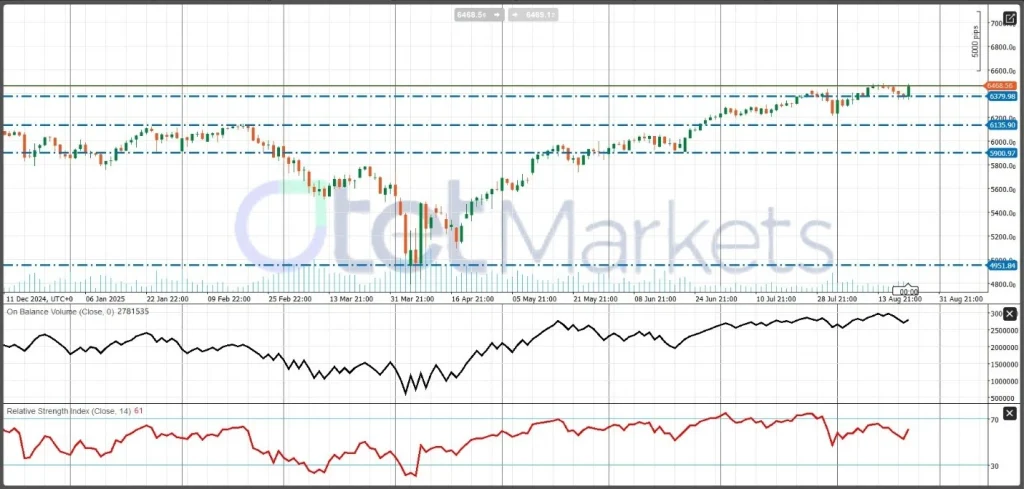
USD – Recent Performance and Weekly Outlook
The U.S. dollar weakened notably last week, with the Dollar Index (DXY) falling nearly 0.9% to 97.58, its lowest in a month. This retreat was broad-based, benefiting major currencies such as the euro and yen. The decline came as market expectations shifted in response to Fed Chair Powell’s dovish comments at Jackson Hole, which suggested rate cuts could be on the horizon due to rising economic risks. As traders anticipated a more accommodative Fed, the dollar lost its yield advantage, especially with other central banks also pausing or easing rates. Improved global risk appetite further reduced demand for the dollar as a safe haven, reversing some of its earlier August strength.
Looking ahead, the dollar’s direction will hinge on upcoming U.S. economic data—especially the core PCE inflation report—and further Fed signals. Softer inflation data would likely reinforce the case for Fed rate cuts and put additional downward pressure on the greenback. Conversely, a surprise uptick in inflation or consumer spending could prompt a temporary rebound, as investors recalibrate expectations for monetary easing.
Global risk sentiment will also play a key role: a risk-on environment (rising equities and commodities) typically weakens the USD, while a sudden risk-off move (triggered by geopolitical tensions or negative surprises) could drive investors back into the dollar. In addition, the Japanese yen warrants close attention as upcoming BoJ policy moves and inflation data could spark USD/JPY volatility.
Technically, the dollar index is trading sideways, with the RSI at 45 and mixed signals from OBV, indicating neither a clear uptrend nor downtrend. Key levels to watch are 98 (resistance) and 97 (support). Overall, the USD faces a weakening bias as long as market sentiment remains optimistic and the Fed appears ready to ease policy, but incoming data could quickly shift the narrative.
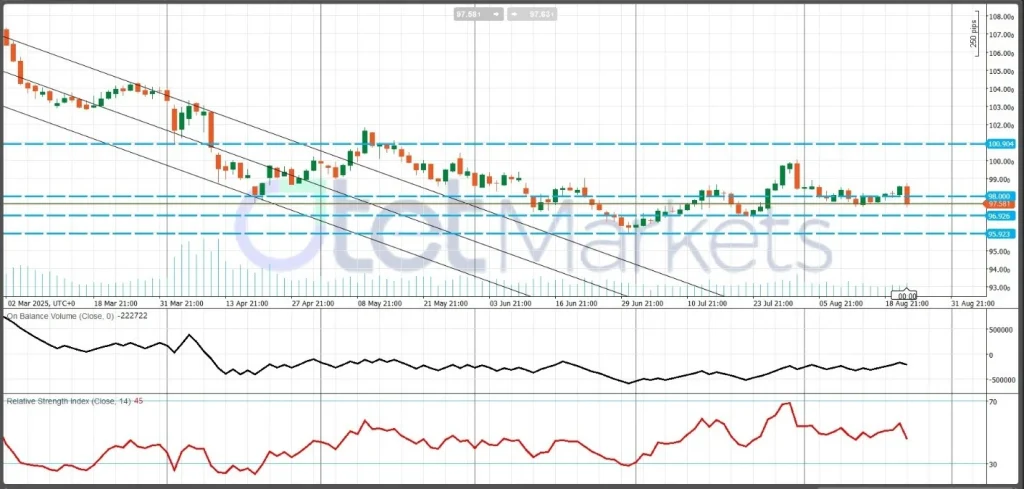
Japanese Economy – Current Conditions and Week Ahead Outlook
Japan’s economy has shown unexpected resilience, outperforming forecasts with robust GDP growth in Q2 2025. The surge was fueled primarily by a rush in exports, as firms accelerated shipments ahead of new U.S. tariffs, providing a temporary lift to industrial activity. While this export front-loading may slow future orders, corporate investment is rebounding, supported by manufacturers expanding capacity after years of disruption. Business confidence remains solid, aided by a weak yen that enhances export competitiveness and a rebound in tourism as international travel continues to recover.
Inflation is moderating but remains above target. In July, both national and core CPI eased to 3.1% year-on-year, down from 3.3%. Monthly readings showed modest price gains, suggesting base effects are helping slow the annual pace even as near-term pressures persist. Notably, prices for traditionally slow-moving categories such as food and household items continue to climb. Wage growth is finally materializing, raising hopes for more sustainable inflation—but also the risk of a wage-price spiral.
Economic activity continues to look healthy. The composite PMI rose to 51.9 in August, driven by a strong services sector (52.7), while manufacturing stabilized just below neutral (49.9). Foreign investors shifted heavily into Japanese equities, purchasing ¥1.16 trillion in stocks and selling ¥314 billion in bonds, signaling confidence in earnings and valuations.
Trade, however, remains a challenge. Japan unexpectedly recorded a ¥117.5 billion trade deficit in July as both exports and imports declined, highlighting weaker demand domestically and abroad—particularly in energy and capital goods. On a brighter note, business investment is rebounding, with core machinery orders up 3.0% month-on-month and 7.6% year-on-year in June, indicating renewed confidence and expansion plans.
Policy remains in focus. The Bank of Japan, under Governor Kazuo Ueda, is under pressure to tighten, even as it cautiously tweaks its ultra-easy stance. The September policy meeting will be closely watched for signs of further normalization, especially if inflation and wage gains persist.
Key data this week—including July industrial production, retail sales, unemployment, and consumer confidence—will shape the outlook. Despite trade headwinds and external risks, Japan enters the week with cautious optimism, underpinned by domestic momentum and steady business investment.
Technical outlook: USDJPY has rebounded toward 150, but with RSI at 47 and OBV slowing, a bearish shift could emerge. Falling below 145 may target 140, while resistance lies at 148 and 149.50.
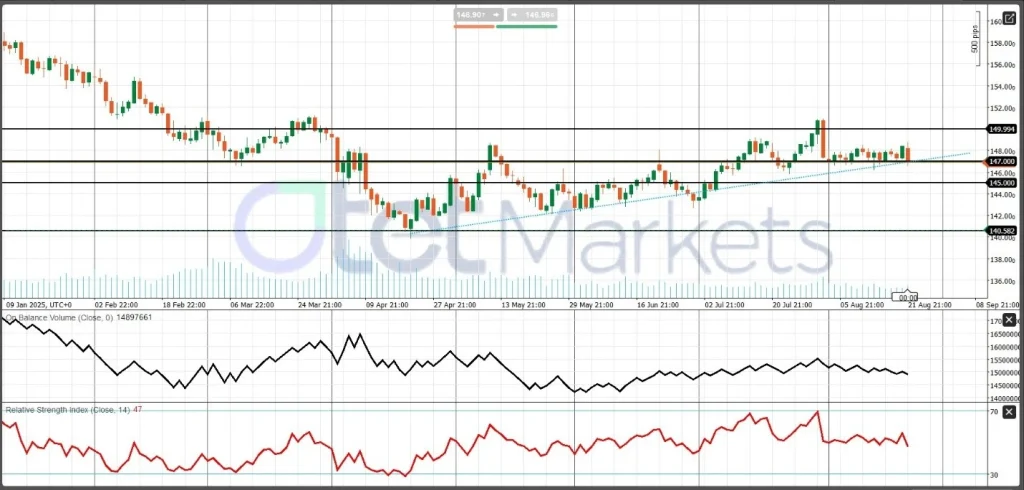
Gold Market – Current Trends and Week Ahead
Gold has been one of 2025’s standout performers, extending its bullish momentum through the past week and trading close to all-time highs. The yellow metal ended the week near $3,375 per ounce, just below record levels set earlier this year. Year-to-date, gold has risen over 25%, reflecting its appeal as a hedge in a world marked by persistent uncertainty and changing monetary policy dynamics.
Last week, gold gained more than 1%, fueled by safe-haven demand and growing expectations for easier monetary policy from the Federal Reserve. The rally gained traction after Fed Chair Powell’s dovish Jackson Hole comments, which weakened the U.S. dollar and pushed bond yields lower. A softer dollar makes gold more affordable for global investors, while lower yields reduce the opportunity cost of holding non-yielding assets like gold. The dollar index’s slide to a one-month low provided further support.
Investors have turned to gold as a buffer against heightened global risks. Trade tensions—particularly new U.S. tariffs—and ongoing geopolitical uncertainties, including the situation in Ukraine and U.S.-China frictions, continue to bolster gold’s safe-haven status. Reflecting this sentiment shift, leading banks have raised their gold price forecasts: Goldman Sachs now sees gold at $3,300 by year-end, with some peers expecting even higher levels into 2026.
Strong fundamentals continue to underpin gold. Central banks worldwide are net buyers, increasing their gold reserves as a diversification move, while inflows into gold-backed ETFs have tightened market supply. Meanwhile, real interest rates remain low or negative in many major economies—a key factor supporting gold, especially with the prospect of the Fed easing and inflation staying elevated.
The outlook for gold remains constructive, though volatility is possible. The environment of monetary easing, global economic slowdown, and U.S. dollar weakness continues to favor gold. For the week ahead, traders will watch U.S. PCE inflation data closely; a soft print could spur another gold rally, while a higher reading might trigger a short-term correction. Geopolitical news, such as updates on Ukraine or U.S.-China tensions, could also drive sharp moves.
Technically, gold holds above its 50-day EMA, signaling bullish momentum. Staying above $3,375 targets $3,450, while a break below $3,300 could pause the bull run. Most daily indicators remain positive, suggesting dips are likely to be seen as buying opportunities unless the macro narrative shifts significantly.
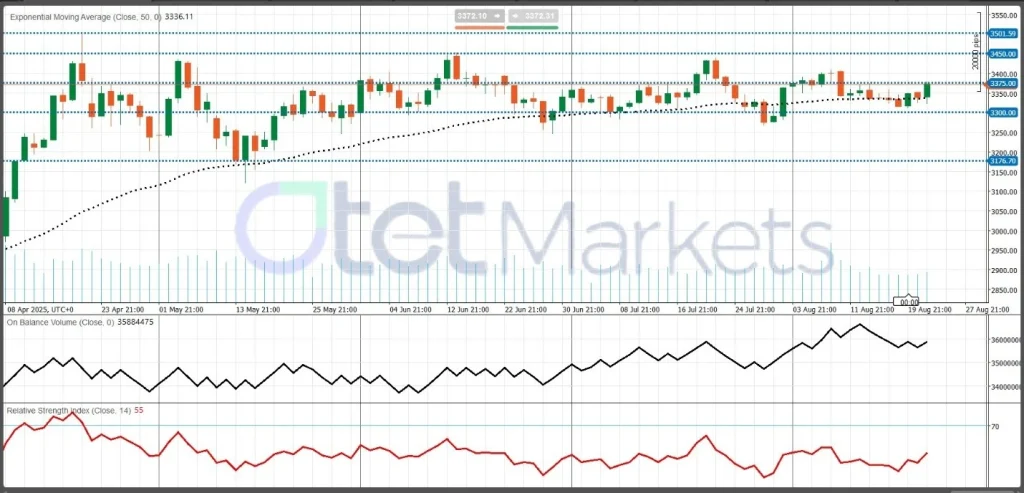
Crude Oil Market – Current Trends and Weekly Outlook
Crude oil markets continue to face downward pressure as supply and demand imbalances weigh more heavily than occasional geopolitical risks. Through mid-August, oil prices remained subdued, with Brent crude briefly dipping to around $65 per barrel and U.S. West Texas Intermediate (WTI) falling below $62—levels last seen in early June. The primary catalyst for this decline was a surprisingly large build in U.S. crude inventories, reported by the EIA, pointing to weaker domestic demand, softer exports, or increased output.
These supply concerns were exacerbated by the International Energy Agency’s (IEA) latest outlook, which downgraded 2025 global demand growth and projected that supply—driven by non-OPEC producers like the U.S.—would outpace demand by up to 2.5 million barrels per day this year. With U.S. crude exports also lagging due to lackluster international demand and trade tensions, the oil market remains in search of a clear bullish catalyst.
Geopolitical events, such as news of a potential meeting between President Trump and President Putin to discuss the Ukraine conflict, provided only brief and limited support. Hopes for a peace deal could eventually lead to normalization of Russian oil exports, further adding to global supply. By week’s end, oil prices saw a modest rebound, aided by technical buying and a softer U.S. dollar, with WTI back near $63.80 and Brent approaching $68.
Inventory data added some support, as U.S. commercial crude stocks unexpectedly fell by 6 million barrels in the latest EIA report, far exceeding forecasts and signaling robust seasonal demand. Gasoline inventories also dropped sharply, while refinery utilization increased slightly, pointing to tighter product markets.
Looking ahead to Week 35, the market remains cautious and highly data-driven. Key factors to watch include OPEC+ communications, U.S. production trends, gasoline demand, and Chinese industrial activity. Weather and geopolitical developments, such as hurricane threats or Middle East tensions, could add volatility. For now, WTI is expected to remain in the low-to-mid $60s, with Brent in the upper $60s, as the market awaits either a notable demand rebound or significant supply restraint to trigger a sustained recovery.
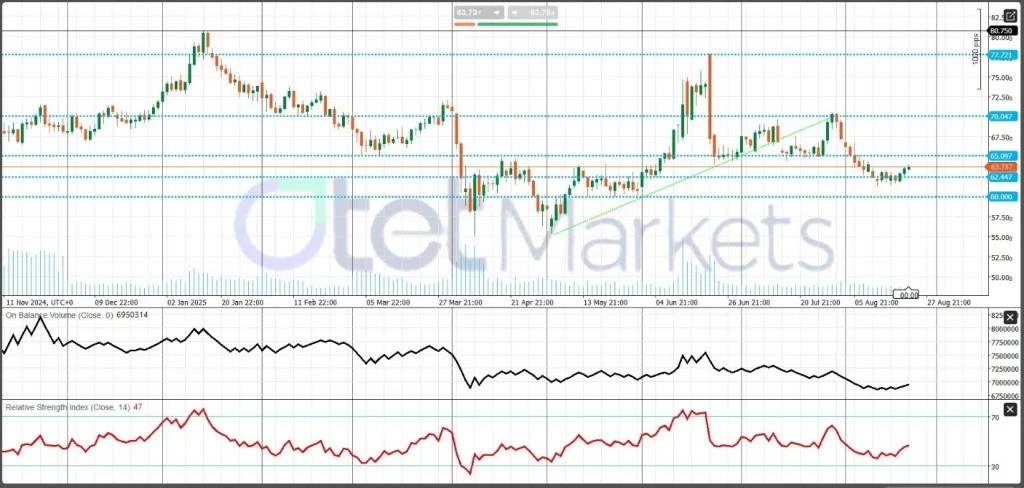
From a technical perspective, $65 plays a key role as support, with technical indicators offering only modest direction. The daily RSI stands at 47, attempting to break above 50, while OBV shows increased interest in buying positions. However, neither bullish nor bearish signals appear dominant, which may prolong the current sideways movement in oil prices.
Cryptocurrency Markets – Overall Review and Bitcoin Expectations
The cryptocurrency market has maintained strong momentum in 2025, buoyed by robust institutional adoption, improved regulatory clarity, and supportive macroeconomic trends such as a weaker U.S. dollar. The total crypto market cap remains near historic highs, hovering around $3.8 trillion after an exceptional rally this year. Bitcoin (BTC), the sector’s benchmark, recently reached a record above $124,000, propelled by optimism over U.S. policy progress, notably Congressional moves toward a clearer digital asset regulatory framework and President Trump’s vocal support for crypto. Surging institutional demand, with large funds and companies adding Bitcoin and Ether as “digital gold” and alternative assets, has further fueled this momentum.
Following its all-time high, Bitcoin saw a typical correction, retracing 8–10% to trade between $112,000 and $117,000. This pullback reflected profit-taking after rapid gains and some caution ahead of Fed Chair Powell’s Jackson Hole speech. Yet, crypto assets rebounded strongly after Powell hinted at potential rate cuts, as a weaker dollar and improved risk appetite reignited buying in both Bitcoin and Ethereum. The rally underscores the sector’s sensitivity to global monetary policy, highlighting Bitcoin’s role as both a hedge and a speculative asset.
Fundamentally, the crypto industry is evolving rapidly. U.S. regulators, under new SEC Chair Warren Atkins, have taken a more cooperative approach, proposing clearer token classifications and updating digital asset regulations. Such moves, alongside legislative advances, have boosted institutional confidence, with sizable company and fund purchases supporting current price levels.
Stablecoins are also seeing progress, with Japan preparing its first yen-pegged token and U.S. states like Wyoming launching regulated stablecoins. These developments enhance liquidity and signal greater governmental acceptance of blockchain technology.
Institutional accumulation remains a key market driver, with major players treating BTC and ETH as strategic reserves. Combined with strong ETF inflows and wider adoption by traditional banks, this trend points to continued mainstreaming.
Looking ahead, Bitcoin is likely to consolidate between $110,000 and $125,000 as markets absorb recent gains. Key resistance stands at $125,000, with strong support at $110,000–$100,000. Further upside could emerge if a spot Bitcoin ETF is approved in the U.S. and as the 2026 halving approaches, reducing supply and attracting fresh demand.
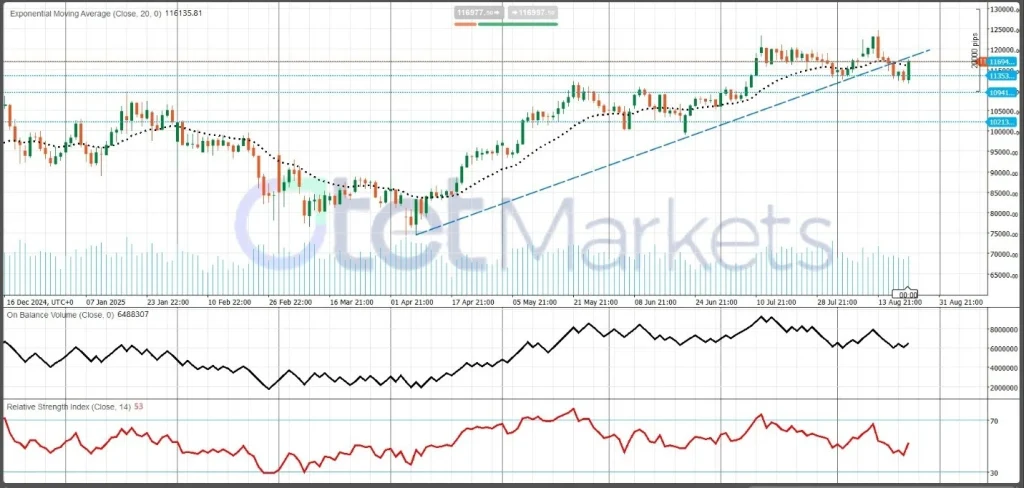
Share
Hot topics
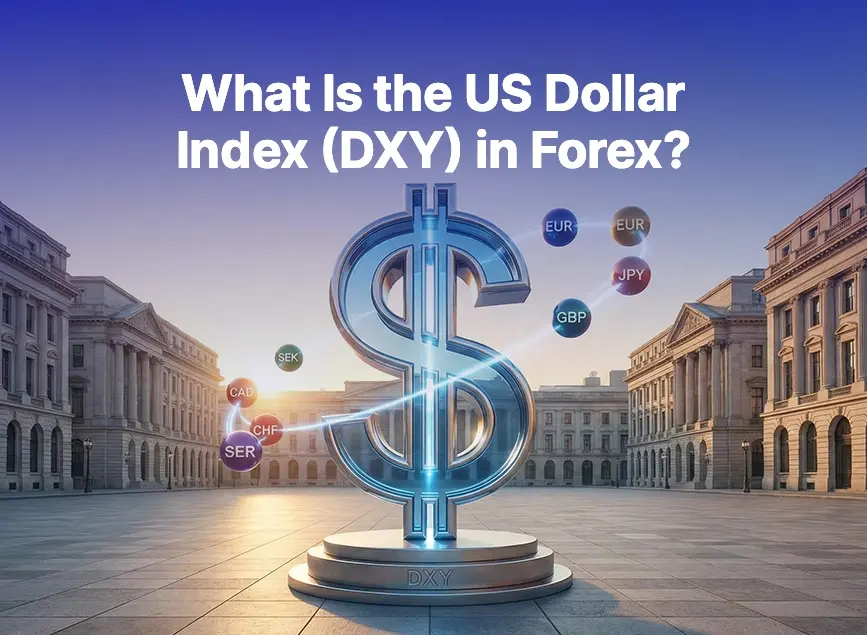
What Is the US Dollar Index (DXY) in Forex?
If you’ve spent any time exploring global markets, you’ve certainly heard about the US Dollar Index, known as DXY. For many beginner traders, it appears to be one of those...
Read more




Submit comment
Your email address will not be published. Required fields are marked *